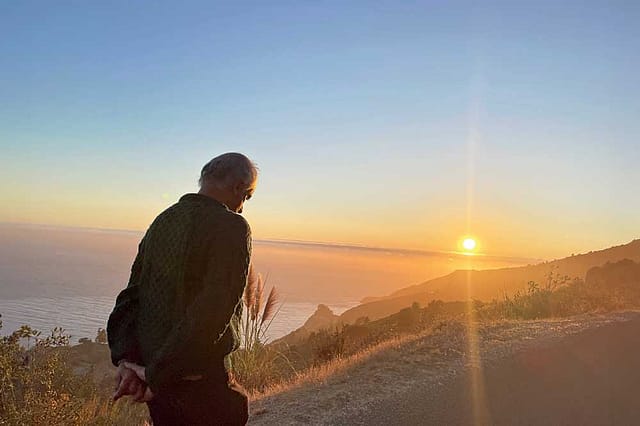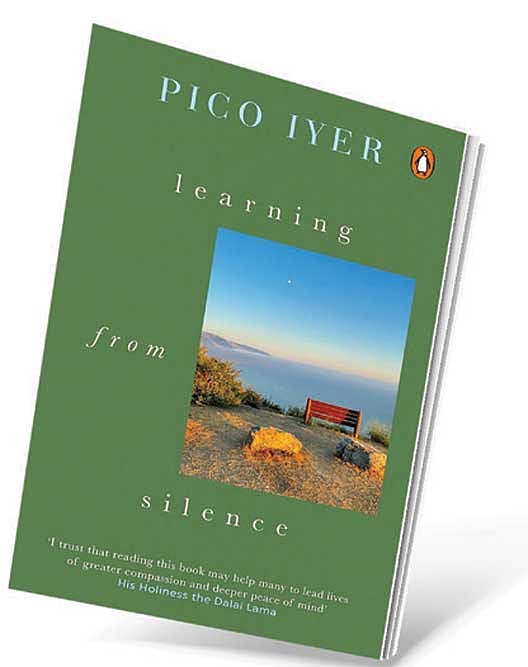‘The best of us resides in our silent self,’ says Pico Iyer

One must start with the basics. Pico Iyer is an uncommonly generous author. The kind who will allow a 40-minute interview to slide into an hour-plus, because he has no wish to rush it. He might be best known as a travel writer, but over time his travel has become more inward rather than outward. All writers are influenced by their location, and Iyer’s move to Nara, Japan, more than three decades ago has altered both his content and style. If his older works were rollicking action-packed accounts, he now has a sparer craft, more bento box than buffet, everything in its place, and nothing in excess. More white space on the page, more room in the margins.
To read Iyer’s most recent book Learning from Silence (Hamish Hamilton; 214 pages; `599) is to revisit many of the basics that his dozen-plus nonfiction books stand upon. The foundational facts are that his family home in California burned to ashes in wildfires, not once but twice. And for 33 years he has practiced solitude, at a remote hermitage near Big Sur, California. The essence is that the force of the fires, the influence of silence reveal to Iyer a few essential truths—you can’t dwell on things (that is the “heart of Zen practice”); to live a monk’s life is not to sequester oneself in solitude, rather it is to be part of a communal web. And the most extreme circumstances show us the wisdom of the Japanese poem, “My house burned down / I can now see better / The rising moon.”
Lost: The Unstoppable Decline of Congress
05 Dec 2025 - Vol 04 | Issue 50
Serial defeats | Leadership in denial | Power struggles
Learning from Silence has moments of uncommon beauty such as the above haiku which remind one that “no event is simply good or bad”. Many sentences and sentiments hang like stalactites from the roof of a cave, each capturing an essential sentiment in perfect prose, such as — “that is what love is: forgetting who you are.” But at other times the ruminations on self and consciousness, the self and everyone can be rather onerous. While at the Catholic monastery, Iyer seems to dwell in a higher radiance and even while he strives to be relatable to the laity— those not living in hermitage time and space—he occasionally does sound like he is talking to one from afar. The difficulty, at times, lies in reconciling the frenzy of our lives with the calm of the Hermitage.
Watch Video
[embed]https://youtu.be/lEIlxmlEbZE?si=XIMVt7F6PG_EUruB[/embed]
When I speak to Iyer, he is in his two-room apartment in Nara. We have discussed his last three books in this same space. Sixty-eight-year-old Iyer says that Learning from Silence can be seen as the companion of his previous book The Half Known Life: In Search of Paradise (2023). These are “brother and sister books, one was travelling around the world to look at paradise and this is about people who are sitting in one place and finding paradise. And bringing that out into the world.” The Half Known Life concludes in Benares in a chapter entitled ‘The Flames of Heaven’. Interestingly, the US edition of Learning from Silence is titled Aflame, which makes the connection between the two books obvious. Fire is the activating force of Learning from Silence just as it is in Benares—the city of joy and death, a place of light and pyres. The monks at the Hermitage live with a constant awareness that a fire can sweep down at any moment and change everything forever. Beyond the literal fires, the monks are always in an endeavour to live “aflame” which is to live “absolutely radiant with conviction that nothing can get the better of you.”
Iyer admits he is “wistful” at the removal of ‘aflame’ from the book’s title in the India and UK editions. He says, “The world is on fire and fire is serving such a central function in the book, literally and metaphorically. I went to the Hermitage because of a fire. The fire is constantly encircling my rebuilt home, and the central question of the book is—how do you keep the inner flames alight when the external flames are rewriting our lives? It was very important for me to have a literal fire as well as fire as a way to pose the question—how do we live in a world of uncertainty and impermanence?”
SILENCE AND SOLITUDE have always been essential to Iyer. As an only child, growing up in a home of professors, he was accustomed to time alone. As a writer, his profession ensures that he works alone. And as a traveller to distant outposts, he is often far removed from the clamour of the familiar. Iyer has never been a man of too many material needs. He has always chosen the simple and disdained the complex. Even today he has no mobile phone and is at peace with his choice. He is reachable by email, his wife does not insist that he get a cell phone (she has one), and so he feels no compulsion to introduce it into his life. He says people in India are always most surprised that he is cell phone-free; in other countries they find it less of an aberration.
While he is relatively free with his money, he says, “Time has been the God before whom I quail and kneel ever since I was a boy, and I’ve been more afraid of time than anything else.” At the monastery he is free of both calendar and clock. Living outside of time allows for liberation. He adds, “A big reason I spend time in the monastery is that time is dissolved and then I am out of time.”
His time at the Hermitage has made him appreciate and understand solitude and silence even more. He says, “It took me a while to realise that the solitude was only a gateway to a richer sense of community, and the only justification for being there is what I could bring back to be a better friend, or husband, or stepfather, or son to the people in my life.” With complete candour he adds, “If I hadn’t gone into that solitude, I probably never would have gotten married.”
A poignant moment in Learning from Silence plays out towards the end when Iyer’s Japanese wife Hiroko Takeuchi visits him at the Hermitage. While her job doesn’t allow her to travel often with him, while she is at the Hermitage she is amazed to meet the many monks who know her husband well and who wondered if she existed at all! After greeting many of them, she turns to Iyer and says, “For thirty years I thought you were an only child. Now I see you have all these brothers.” This line, spoken by the heroine of Iyer’s beloved early memoir, The Lady and the Monk: Four Seasons in Kyoto (1991), serves as the spine of Learning from Silence, as it highlights the importance of community for monks, and the brotherhood of silence.
If being in silence has altered his relationships, I ask him if silence has changed his writing. Iyer feels that his immersion in Japan has changed his writing “dramatically” while his time at the Hermitage has channelled more silence into his work. He says, “Spending time in that silence has taught me that words are only as rich and deep as a silence that surrounds them and lies under them.”
While he is at the Hermitage he feels his speech changes too. He notices that the fellow monks seldom, if ever, use fillers such as ‘um’ and ‘ah’, with which we garnish our conversation. Their exchanges become deeper because they are more considered and less superfluous and hardly frequent. He adds, “Because of their close acquaintance with silence, their thoughts come out fully rounded and there isn’t hesitation and they’re bringing out these perfectly shaped pebbles from a deep pond.” As an author, he is always in search of the unique and the unsaid, but at the Hermitage he realises his voice is communal rather than singular. He says, “Everything I write while I’m in the monastery is probably word for word what each other person staying there at the same time is writing. We’re all speaking with the same voice.”
While at the Hermitage, and embedded in silence, Iyer keeps notes. Over the last three decades he has accumulated over 4,000 pages. The challenge was how to make those notes comprehensible to a lay reader. He explains, “Those notes are just too peaceful to translate to the clamorous world. They wouldn’t make sense to somebody in rush hour traffic. They sound like somebody whispering to himself in an empty room above the clouds because they are essentially so. Everything that comes out of me there feels right and true, but I just realised it’s too removed from friction and conflict to make sense to people who aren’t in that rather enchanted setting. And so in the process of sifting, I try to really just take a series of representative moments, each of which could function as almost a self-contained parable.” “Ninety-seven percent” of the pages he’s written there are just him “in ecstasy, giving thanks to the universe.” In order to make the book relevant to a reader who might be rushing her kids to school while she is readying for work, he needed to go beyond the ecstasy and to interrogate more essential elements such as faith and doubt, self and community. He adds, “I wanted to bring in a lot of darkness and storm and doubt into the book because doubt is famously the centrepiece of faith.”
To examine doubt and faith, Iyer often turns to other spiritual leaders, thinkers and authors, such as the Dalai Lama, George Saunders, Leonard Cohen and Henry David Thoreau to name just a handful. He writes movingly about Cohen who the world might know as the profound poet with a raspy voice, but who was once a dedicated monk at the same Hermitage as Iyer. The author encountered a man who had relinquished all the trappings of fame and who lived a humble life of service and meditation. What is your most cherished memory of Cohen, I ask Iyer. He recounts enjoying lunch with him and his daughter at their home. Cohen regaled the lunch party with literary anecdotes and bravado tales of working along the beaches of Cuba during the Bay of Pigs. After lunch he invited Iyer to come sit with him in the garden on two little folding chairs. They sat there saying nothing for 15-20 minutes. After which, Iyer thought he was encroaching on Cohen’s time and got up to leave. Cohen (his teacher gave him the name Jikan meaning ‘the silence between two thoughts’) beseeched him to stay. Iyer says Cohen was “wise enough to know that silence was the best gift he could share with somebody.” He adds, “I think in the process of writing this book, I began to think that all of us have a social self which we need to engage with the world. But we all have a silent self, which is where the best in us resides, and Leonard Cohen had done a beautiful job through being a monk of really activating and releasing his silent self.”
The title, Learning from Silence, might sound didactic. But given Iyer’s innate humility, good humour and scale of spirit this is not a preachy book. This is a parable, which urges us towards contemplation and quietude. It is a book that ultimately reminds one, “Everything will be alright in the end… If it’s not all right, it’s not the end.”

